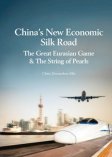China’s Belt Road Import Growth Overtakes Export Growth for the First Time

China’s imports from “Belt and Road” countries increased faster that of exports for the first time, in 2017, according to China’s State Information Center.
The value of goods exported to China from Belt and Road nations reached US$666 billion last year, an increase of 20 percent year on year. This represented 39 percent of China’s total import value, according to the SIC.
That compared to China’s exports to these same countries at US$774.26 billion, shows a rise of 8.5 percent year on year. The growth of imports outpaced exports for the first time since the Belt and Road Initiative was proposed five years ago.
Chris Devonshire-Ellis of Dezan Shira & Associates comments: “These figures are a bit of a window dressing by the SIC as China still actually exported more than it imported. They want to show that a more level “win-win” trade field is developing. Nevertheless, these figures do illustrate a narrowing of the China trade deficit in many countries, although much of China’s import figures are still based on energy resources rather than consumer needs.”
China’s combined Belt and Road trade, meanwhile, reached US$1.44 trillion, an increase of 13.4 percent year on year, and 5.9 percentage points faster than China’s overall trade growth.
China’s trade with Central Asia countries grew at the fastest rate, followed by Eastern Europe. Countries including Republic of Korea, Vietnam, Malaysia, India, and Russia rank among China’s top 10 trading partners along the routes, contributing nearly 70 percent of China’s trade with Belt and Road countries.
China mainly sells mechanical and electrical products to Belt and Road countries, and imports mechanical and electrical products as well as fossil fuel from them, the report said.
Chinese private companies do the biggest chunk of trade, followed by foreign-invested companies and state-owned firms.
Devonshire-Ellis concludes: “There are, however, great opportunities to sell directly to Chinese consumers, and it is significant that private Chinese companies make up the bulk of the trade. That indicates consumer product demand. Selling online to China, with currently 600 million online purchasers, is the way to get at the China market. Belt and Road businesses can look at getting their products onto Chinese e-commerce portals and begin to satisfy this. It is a hugely important area with plenty of growth potential. The Chinese government has already stated they want one billion Chinese buying products online by 2020. It is time now to examine Chinese e-commerce trends and how to present products to these markets in the optimum manner.”
About Us
Silk Road Briefing is produced by Dezan Shira & Associates. The firm provides business intelligence, investment advisory, due diligence, tax advisory, corporate establishment and structuring, accounting, payroll and related professional services throughout Asia and has business experience dealing with both Mongolia and North Korea. To contact us please email silkroad@dezshira.com or visit us at www.dezshira.com
 Related Reading:
Related Reading:
Silk Road and OBOR Business Intelligence
Dezan Shira & Associates´ Silk Road and OBOR investment brochure offers an introduction to the region and an overview of the services provided by the firm. It is Dezan Shira´s mission to guide investors through the Silk Road´s complex regulatory environment and assist with all aspects of establishing, maintaining and growing business operations in the region.
Cross Border e-Commerce in China
While cross border e-commerce (CBEC) is an attractive channel for foreign businesses to sell to China, misunderstandings over how CBEC in China works frequently end in costly disappointments and retreats from the market. In this issue of China Briefing magazine, we offer foreign investors a practical guide to selling to China through CBEC. We begin by introducing the market landscape, before diving in to the sector’s legal and regulatory framework. We then compare the advantages and disadvantages of different CBEC business models. Finally, we consider how to protect intellectual property in China when selling online.
China’s New Economic Silk Road
This unique and currently only available study into the proposed Silk Road Economic Belt examines the institutional, financial and infrastructure projects that are currently underway and in the planning stage across the entire region. Covering over 60 countries, this book explores the regional reforms, potential problems, opportunities and longer term impact that the Silk Road will have upon Asia, Africa, the Middle East, Europe and the United States.








